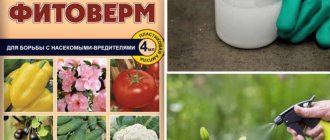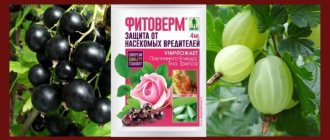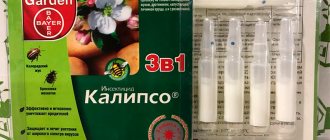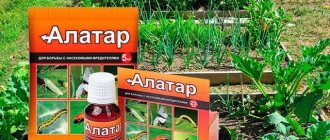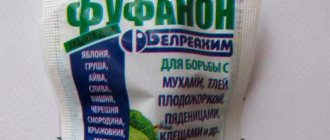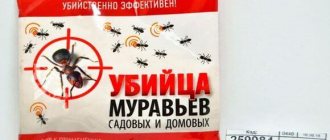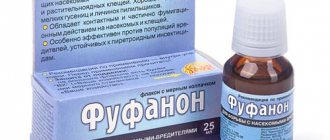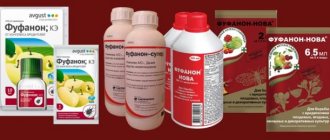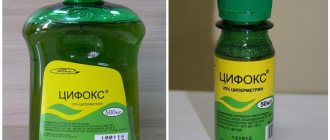Author: Elena N. https://floristics.info/ru/index.php?option=com_contact&view=contact&id=19 Category: Insecticides Published: February 26, 2012Republished: February 26, 2019Last edits: March 12, 2021
For those who are looking for an effective broad-spectrum product of biological origin to protect their plants from pests, we offer information about the drug Fitoverm, which has proven itself well both in small personal plots and in agriculture. Fitoverm produced by NPC Pharmbiomed LLC is simply a champion among insecticides, so let’s talk about it in more detail.
Purpose of Fitoverma
Fitoverm is a broad-spectrum enteric-contact insectoacaricide that destroys more than twenty types of pests, including the Colorado potato beetle, cabbage and turnip moths, cabbage cutworm, various mites, apple flower beetles and codling moths, all types of aphids, thrips, potato and ermine moths, sea buckthorn fly , root-knot nematodes, circle leaf miner, small apple leaf miner, topside leaf miner, gray beet and raspberry-strawberry weevils, moths, leaf rollers, whiteflies, potato ladybugs and other plant enemies.
Fitoverm is used on grain crops, strawberries, cabbage, potatoes, nightshade plants, raspberries, cucumbers, roses, sugar beets, currants, apple trees, hops, flowers and other crops.
Plant pests beet fly and garden fatty leg
Beet leaf miner
lays eggs on the underside of young leaves. After a few days, the larvae hatch, which, penetrating the leaf tissue, eat away the pulp in it, as if they were mining the leaf. As a result, swollen gray-yellow spots form on the surface of the leaf.
Damaged leaves change color, turn yellow and dry out. The next generation of larvae appears in late July or early August and damages the leaves of adult plants. In the southern regions, a third generation of beet fly may appear.
One of the dangerous pests that harm fruit trees is the cherry fly. Fighting it will require considerable effort and time. This insect can easily ruin the entire harvest. The fly lays its eggs in the fruits of cherries. After some time, larvae emerge from them and eat the pulp in the berries. In damaged fruits, a rotting process occurs. This is what leads to crop damage.
Action of Fitoverm
The active component of the drug is aversectin C, a waste product of the soil fungus Stereptomyces avermitilis. Fitoverm, entering the digestive system, paralyzes the nervous system of pests, and after 2-3 days their death occurs. The beginning of the effect from the moment of treatment is after 6-8 hours in protected and after 8-16 hours in open ground. The maximum effect is achieved on days 5-7. In the soil, the active substance breaks down into non-toxic compounds within 48 hours.
- How to use Acarin against ticks
Observations have shown that Fitoverm on shrubs and fruit trees reduces the number of harmful insects by 94-100%, and ticks by 96-100%. When applied in hot weather, the drug, unlike other protective agents, does not burn plant leaves. Fitoverm achieves optimal effectiveness at temperatures from 15 to 25 ºC. It does not pollute the environment and quickly decomposes not only in soil, but also in water. The waiting period from the moment of processing to harvesting the fruits is no more than three days.
It is advisable to treat plants in soil protected from ticks with Fitoverm three times. After the first spraying, most of the females and nymphs of the tick die. The second spraying is carried out a week after the first, and the third - 2 weeks after the second. Within a month, all females, larvae and eggs of the tick die. The protective effect of Fitoverm lasts up to 3 weeks. To prevent the occurrence of resistance, it is advisable to alternate Fitoverm with acaricides and insecticides of other chemical groups.
Analogs of the drug to one degree or another are Cesar, Zephyr, Abacus, Vertimek, Actofit and Gaupsin.
Advantages of Fitoverm:
- ease of use;
- Possibility of application three days before harvest;
- increased efficiency at high temperatures;
- relative harmlessness to the environment;
- lack of phytotoxicity;
- rapid decomposition in water and soil;
- long-term protective effect.
Pros and cons of the product
The biologically pure drug Fitoverm shows excellent results. The reviews left by farmers are predominantly positive, since with proper use of the substance, as well as a thorough understanding of the recommended processing rules in the instructions for use, the biological product does not give negative results.
Even packaging is provided for small and large areas.
To make sure that you choose the right product from those offered on the agricultural products market, let’s consider the pros and cons of Fitoverm:
| Advantages | Flaws |
| Convenient packaging. Possibility of purchasing the required quantity | High price when compared with the proposed pest control products |
| Non-addictive with long-term use | Processing must be done multiple times |
| Biologically pure product that leaves no traces in the environment | Cannot be used in combination with other substances |
| Does not affect plant development, has no negative impact on soil or crops | Kills not only harmful insects, but bees and other honey plants |
| The third class of danger, which means it does not pose a threat to animals or people | Not suitable for soil application |
| Fixes problems quickly. The spectrum of action includes more than 2 dozen species of insects |
The decay period of the main component is very fast (up to three days), but the active effect does not stop. This is an additional advantage that attracts buyers.
Also considered a positive aspect is the ability to work with Fitoverm during persistent heat. 85% of pest control products cannot be used in hot weather.
Instructions for use Fitoverm
The drug is available in ampoules of 2, 4, 5 ml, in bottles of 20, 50 and 100 ml, as well as in canisters of 1 and 5 liters. The working solution must be prepared immediately before use. Pour 1-2 liters of water into a bucket, open the ampoule or bottle, measure and pour into the bucket the dose of the drug required to prepare 10 liters of solution, stir thoroughly, and then, while stirring, bring the solution with water to the required volume.
Plants should be sprayed in calm and clear weather in the morning, before 10 o'clock, or in the evening, after 18 o'clock. You should not treat plants if precipitation is expected within 6 hours after treatment. The leaves must be thoroughly moistened with the solution on both sides. In the absence of precipitation, the drug continues to act for one to three weeks. If it rains, the effect of the drug is greatly reduced.
| Culture | Pest | Consumption of the drug (per 1 liter of water) | Solution consumption | Time of processing | Number of treatments / waiting period |
| Apple tree | Mite, leaf roller, moth | 1.5 ml | 2-5 l / 1 tree | Growing season | 2/2 |
| Apple tree | Cutworms and codling moths | 2 ml | 2-5 l / 1 tree | Growing season | 1/2 |
| Currant | Leaf rollers, moths | 1.5 ml | 1 l / 1 bush | Growing season | 2/2 |
| Currant | Ticks | 2 ml | 1 l / 1 bush | Growing season | 2/2 |
| Potato | Colorado beetle | 1 ml | 5 l / 100 m2 | Growing season | 1-3/1 |
| Cabbage | Cabbage white and scoop, turnip white | 1 ml | 4 l / 100 m2 | Growing season | 1-2/1 |
| Peppers, tomatoes, cucumbers, eggplants (protected soil) | Aphid | 4-6 ml | 10 l / 100 m2 | Growing season | 2-3/2 |
| Peppers, tomatoes, cucumbers, eggplants (protected soil) | Thrips | 10 ml | 10 l / 100 m2 | Growing season | 2-3/3 |
| Peppers, tomatoes, cucumbers, eggplants (protected soil) | Spider mite | 1 ml | 10 l / 100 m2 | Growing season | 2/2 |
| Houseplants | Aphid | 8 ml | 0.1-0.5 l / 1 m2 | When pests appear | 2-4/2 |
| Houseplants | Thrips | 10 ml | 0.1-0.5 l / 1 m2 | When pests appear | 2-4/2 |
| Houseplants | Spider mite | 2 ml | 0.1-0.5 l / 1 m2 | When pests appear | 2-4/2 |
| Flowers (protected ground) | Thrips | 8 ml | 10 l / 100 m2 | Flowering period | 2-3/2 |
| Flowers (protected ground) | Aphid | 4 ml | 10 l / 100 m2 | Growing season | 2-3/2 |
| Flowers (protected ground) | Spider mite | 2 ml | 10 l / 100 m2 | Growing season | 2-3/2 |
| Flowers (open ground) | Thrips | 10 ml | 10 l / 100 m2 | When pests appear | 2-4/2 |
| Flowers (open ground) | Aphid | 8 ml | 10 l / 100 m2 | When pests appear | 2-4/2 |
| Flowers (open ground) | Spider mite | 2 ml | 10 l / 100 m2 | When pests appear | 2-4/2 |
Biological pest control product Fitoverm
Fitoverm is a biological preparation that destroys an impressive proportion of garden and garden pests.
It is used on all types of open and protected ground crops, including indoor plants.
Fitoverm belongs to the group of insectoacaricides, that is, the product is effective against both leaf-eating insects and mites:
- Colorado potato beetle;
- sawfly;
- codling moths;
- moths;
- all types of aphids;
- gall mite;
- herbivorous mites;
- scale insects;
- leaf rollers;
- whiteflies;
- thrips;
- mealbugs;
- caterpillars;
- cutworm and other pest butterflies;
- moles.
- and so on.
In total, it protects green spaces from 20 types of dangerous harmful insects and ticks.
The drug is produced by LLC NBC "Pharmbiomed" in vessels of different volumes - in ampoules from 2 to 100 milliliters for private use; in bottles of 200, 400 milliliters and canisters of 1-5 liters for farms. The active agent of Fitoverm is Avermectin S, standard dosage 2 g/l.
Usually the name of the pesticide is accompanied by the abbreviation EC. It stands for "concentrated emulsion".
There are several subspecies on sale:
- Fitoverm M has acaricidal and insecticidal properties and works equally well in an open garden bed and in a greenhouse.
- Fitoverm Forte contains more active substance (10 g/l), which allows you to effectively eradicate ticks.
- Fitoverm P is produced in powder form and is intended to combat nematodes.
If the area is large, I advise you to buy the drug in a large package. This makes it more economical.
Precautionary measures
- While working with the drug, it is forbidden to eat, drink or smoke.
- The use of safety glasses, protective clothing, gloves and a respirator is mandatory.
- After spraying, wash your face and hands with soapy water and rinse your mouth with clean water.
If you spill the drug, fill the area with some sorbent: sawdust, sand, peat or granulated clay, then collect the sorbent and neutralize it with a five percent alkali solution.
The container of the drug should not be thrown into landfills or water bodies. Do not use empty containers under any circumstances: they must be burned in a specially designated place, being careful not to inhale the smoke.
Development
After the larva enters the soil, a false cocoon begins to form. This happens in approximately 5-6 days. The pest waits out the winter in the pupal stage. The largest number of them can be found by digging up the ground around a tree. They do not dive very deeply - no more than 5 cm. The optimal temperature at which the cherry fly pupa is formed is no higher than +10 ° C.
The larva leaves the false cocoon with the arrival of spring. At first she remains motionless. It is difficult to confuse it with another insect, since it has a characteristic gray-orange color. She remains motionless for approximately 5 hours. After this period of time, its wings dry out and their color changes. The fly gains the ability to fly. This phase lasts about two months (from May to July).
First aid
The recommendations below are intended only for providing FIRST aid, after which you should immediately consult a doctor and follow his instructions! DO NOT SELF-medicate!
- If the drug gets into your eyes, rinse them with plenty of running water, trying to keep them open.
- If Fitoverm gets on the skin, it should be washed off with plenty of soapy water.
- If the drug gets into the gastrointestinal tract, you must take activated carbon at the rate of 1 tablet per 10 kg of body weight, wash it down with 3-4 glasses of water and induce vomiting.
- There is no antidote for Fitoverm, so treatment eliminates the symptoms of poisoning. If you feel sick, call your doctor or poison control center.
Sharing with other tools
Storage of the drug in finished form is not provided. Opened packaging of the substance can be stored strictly according to the periods indicated on the packaging. There is no point in processing crops after the expiration date.
Place for storing packaging: room for agricultural materials, away from fungicides and similar preparations. The temperature should not exceed 30 degrees Celsius. Children and animals should not be allowed near the substance. Although Fitoverm is not toxic, in concentrated form it causes allergies and poisoning if inhaled.
Combining treatment with Fitoverm with other drugs is prohibited. The minimum gap can be no more than 3 days.
Reviews
Maria: the drug is relatively safe, does not overwhelm you with the smell, but requires several treatments. I used it on roses and was pleased.
Marina: I was captivated by the fact that Fitoverm is of biological origin. In addition, it has an affordable price, it dissolves well in water and does not smell very much (sorry). I also liked the fact that the ampoules are not glass (I usually cut my hands with them), but plastic. Well, I liked the effect: not lightning fast, but reliable.
Agasha: This is not the first time I have encountered spider mites on indoor plants, so I know a lot about preparations. I bought Fitoverm because it is relatively safe for the environment. I had to spray the plants twice, but I didn’t expect quick results: I also treated them with Actellik twice. The second treatment is a control shot. I heard people complain about the smell of Fitoverm. People, you probably haven’t snorted any other drugs!
- How to use Tanrek in the garden against pests
Sergey: this drug is relatively harmless to the environment, therefore, probably, its effectiveness in the fight against parasites is very relative. I treated currants against aphids with Fitoverm, but the result was more than modest. I had to use the proven Kinmiks. Maybe I was in a hurry and should have waited...
Anatoly: I used Fitoverm against spider mites on cucumbers in a greenhouse. After processing, I closed the greenhouse and entered it only the next morning. The cucumber leaves, which were withered, perked up slightly, and after two days their turgor was completely restored. Just in case, I re-processed it. Since then the ticks have not appeared.
Official website and manufacturer's recommendations: https://dacha.avgust.com/catalog/fitoverm/
Who harms cherries?
Unfortunately, the army of insects that harm cherry trees is quite numerous. It is very dangerous when pests begin a massive invasion of the garden, so it is necessary not to wait for such situations, but to carry out mandatory preventive measures. But first, let's deal with the “portraits” of insects that are enemies of cherries.
Cherry aphid
The cherry aphid is a microscopic black or sometimes green insect that settles in entire colonies on the leaves, stalks and tops of tree branches. The larvae appear in the spring, they suck the juice from the leaves, as a result of which the leaves stop growing, wither, dry out and die. Flying females carry the larvae throughout the garden, and all trees are exposed to aphid infestation. Very often, ants appear along with aphids, attracted by the secretions of the larvae, which they use as food.
Slimy sawfly
Another enemy of cherries is the cherry slimy sawfly, which lays its larvae on the leaves of the tree. Leech larvae mercilessly eat all the foliage, the trees dry out, presenting a very sad sight.
Cherry weevil
It is a small bug of bronze-lilac color. It appears on cherries in the spring, actively eats buds, flowers and young ovaries, and already in mid-summer, female weevils lay new larvae in still green berries. The larvae feed on fruit seeds, gnawing them from the inside, which leads to spoilage of berries, falling and loss of yield. Infestations of the cherry weevil are often widespread, therefore, if measures are not taken, the gardener will not see ripe cherries.
Golden silkworm or goldtail
Lacewings are butterflies that lay eggs in the foliage of cherry trees. The larvae that then appear eat the leaves, and the damaged foliage with only veins is then wrapped in cobwebs. In these unique cocoons, silkworm caterpillars hide for the winter, and then in the spring, after hibernation, they feed on young cherry buds.
Shoot moth
The danger comes from the greenish-yellow larvae of this butterfly, which in the spring eat cherry buds, newly emerging leaves, and buds. The buds and leaves dry out and curl up, resembling frost damage.
Bark beetle
The bark beetle is dangerous not only for cherries, but also for sweet cherries, as well as for all trees in the garden. Females of this insect gnaw winding passages in the bark of fruit trees, where they lay eggs. The emerging bark beetle larvae feed on wood, causing irreparable damage to both young and mature trees.
Sapwood
Insects that, like bark beetles, damage cherry wood. They settle in the sapwood under the bark, gnaw out passages, corridors, and large holes from which gum can ooze. Cherries that are affected by sapwood stop growing and dry out. If you do not notice these pests in time, then at an advanced stage it is very difficult to fight sapwood.
cherry fly
This insect loves to eat ripe cherry fruits, and if damaged berries are not detected, you can lose up to a third of the harvest. The fly lays eggs in the berries, and then the emerging larvae feed on the ripe pulp. Cherry fruits become soft, with depressions, and spoiled.
Plum moth
Despite this name, this pest affects both plums and cherry fruits. It is a butterfly with purple wings, but the most terrible damage is caused to cherries by the larvae of the codling moth - yellow-brown caterpillars. The butterfly lays eggs in unripe cherry fruits, and the hatched larvae begin to devour the pulp en masse. The cherry berries turn out to be wormy, and the harvest is ruined.
Preventing the appearance of midges in indoor flowers
To prevent pests from infecting house plants, you must adhere to the following recommendations:
- regularly remove fallen and yellow leaves;
- adhere to moderate watering, preferably on a schedule;
- loosen the soil;
- do not pour tea or coffee leaves under the flower, do not use organic fertilizers;
- regularly inspect the leaves and manually remove any pests that appear;
- To plant plants, use purchased soil; garden soil must be disinfected with preparations, steamed or frozen;
- Place foam chips or other drainage on the bottom of the pot to prevent water stagnation.
If one indoor plant is affected, then insect prevention should be carried out for all the others. This will help protect them from infection.
With the right approach, getting rid of midges in indoor pots is easy. If you don’t start the fight in a timely manner, the entire flower garden will die.
Ways to get rid of midges in house plants
When the first signs of infection appear, you need to act immediately. In the fight against midges, it is advisable to use folk remedies and chemicals. The former are safer, so they should be preferred.
The infected plant must be immediately removed away from others.
Carrying out preventive measures will help protect indoor flowers from midges:
- replanting plants using purchased soil, the old one needs to be thrown away; sometimes only the top layer of soil can be replaced;
- choosing a pot with holes in the bottom;
- proper watering - do not allow waterlogging.
Preparations for midges
In case of large-scale infection, it is better to use proven means that will ensure maximum effectiveness. These are insecticides. They are toxic, so it is better to carry out the treatment on the balcony or street with the mandatory use of protective equipment.
The following drugs are effective against midges in flowers:
- Aktara. The product is spilled on the soil or sprayed on the leaves. Shows the best results in combination with Actellik.
- Agravertine. Water the flower with the prepared solution once a week, watering is prohibited for the next 5 days; apply for 15 days.
- Fitoverm. A safe and effective biological remedy for flower midges. Several treatments are sufficient for treatment; There is no chance of leaf burns.
- Bazudin. It comes in granules that do not need to be dissolved in water; they are mixed with soil. Analogue – Grom-2.
- Intavir. Quickly copes with insect pests.
- Fly eater. Destroys larvae; Available in granules.
- Fitosporin. A broad-spectrum bioinsecticide that not only copes with midges, but also saves against fungal and infectious diseases.
- Dichlorvos or Raptor. The aerosol is effective in combating adults and larvae. You need to spray everything - leaves, soil, pot, tray. It is better to take the treated plant out into the fresh air. Inexpensive substitutes are Ambush and Cypermethrin.
To increase the effectiveness of the insecticide, you should add shampoo or dissolve a piece of laundry soap to the prepared solution.
Folk remedies
To get rid of midges, gardeners use simple methods:
- they stop watering for a while and without moisture the insects die;
- stick an orange or other citrus fruit peel into the ground around the perimeter of the pot - midges do not like strong odors;
- water with a garlic solution - pass 3 heads through the garlic, add 1 liter of water, leave for 4 hours - or bury the cloves in the soil;
- sprinkle the surface of the soil with wood ash;
- stick matches into the ground with sulfur facing down and water them; the flies will die in a week;
- spill the top layer of soil with a weak solution of potassium permanganate; the procedure is repeated every 2 days;
- use grated laundry soap: 20 g per 1 liter of water; Leaves and soil are treated with the resulting product;
- pour over tobacco infusion: add 50 g of the product to 1 liter of water, leave for 2 days.
Processing rules
Preparation of the working solution is carried out immediately before using the drug in compliance with the dosages. For dilution, do not use containers in which food is prepared ; after use, they must be thoroughly washed. It is better to use disposable tableware. How to dilute Fitoverm is indicated in the article below.
When choosing a treatment day, pay attention to the weather. On a rainy day or with high humidity, the treatment will not bring the desired results. It was noticed that on a hot day (air temperature from 24 to 32 °C) the effect of using the drug against spider mites increases up to 4.8 times, and when the temperature drops to 17 ○C, it drops by 7.6 times.
To treat cultivated plants with Fitoverm, use a spray bottle. At the same time, make sure that the product is distributed evenly - it is under these conditions that most pests die. In this way, fruit trees and abundantly vegetating plants are treated.
Indoor plants are treated by carefully lubricating each leaf on both sides with the solution. The remains of the drug are poured onto the soil in the pot . This is necessary because splashes and vapors of the drug in a closed room can enter the lungs.
Fitoverm must be used at least four times, with an interval of 7-9 days.
DIY traps
A cherry fly has appeared in the garden plot; measures to combat it do not present any difficulty. Those who are opposed to chemicals containing toxic substances are advised to build their own traps. In order for them to be effective, they must be used in early spring, as soon as warm temperatures have established.
Homemade traps can be of two types: liquid and glue. For the former, any sweet compositions are used. An aqueous solution of honey, compote, beer or kvass will do. They are poured into any available means, like a plastic bottle or some other container. In order for the pest to fall into these traps, they must be hung on trees. The smell emitted by the liquid attracts pests, they fly into the container and drown in it. For such traps to be effective, the filler must be renewed periodically.
Another type that is used in pest control is no less popular. We are talking about glue traps. In order to make them, you do not need to have any special skills. To do this, it is enough to purchase glue, which takes a long time to dry, and cardboard. It is advisable to choose yellow for the latter. An adhesive is applied to the base, and the resulting traps are hung on trees. When they are covered with a large number of flies, they need to be replaced with new ones.

